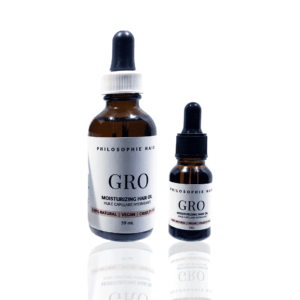- 1-905-452-8193
- Contact Us
- Member Login
- Get Listed Today
- 220,911 members

The hair care journey is a long and personal one. Finding the right hair products that suit your hair type is pertinent to ensuring healthy, lustrous hair. One of the cost-effective solutions is using hair oil. However, selecting the right hair oil for your hair type is key to unlocking its full potential. In this article, Philosophie Hair will guide you through the process of finding the perfect hair oil to address your specific hair needs.
Understanding hair types
Before selecting the right hair oil, you need to understand your hair type. The four factors to fully understand your hair type are-
Hair texture
Hair Structure
Hair Porosity
Scalp moisture
1. Hair texture
Hair texture is the natural shape or pattern of your hair strands. Women often get confused about which category they fall into. The best way to be sure of your hair texture is to leave it free of products and let it dry the next time you wash it. If your hair dries straight without any bend or curl, you have straight hair. If your hair is in an S shape, then you have wavy hair. On the other hand, if your hair dries with a curl or loop pattern, you have curl types.
However, remember, just as two people have a natural wave in their hair, that does not mean they have the same exact type. This is because hair type contains subcategories for each of the four textures.
2. Hair Structure
Hair structure refers to the thickness of strands, which also, to some extent, determines how well your locks hold different hairstyles and how certain hair reacts with products. Typically, your hair falls into three categories: fine, medium, and coarse (or thick).
One of the easiest ways to determine whether you have thick or thin hair is to take a single strand from your hairbrush and lay it down on a plain, flat surface. Next, place a thread (try to choose a thread of the same color as your hair) on the strand of your hair. If your hair strand is thinner than sewing thread, it shows you have thin hair, while if it seems thicker, it's likely to fall into the category of coarse.
3. Hair Porosity
Hair porosity refers to the hair's ability to absorb the product. Understanding hair porosity can help you determine the type of styling products you should be putting on your hair.
To know your hair porosity, place a single strain of hair in a bowl of water. If your hair strand sinks to the bottom, it indicates you have high porosity, while if the strand remains below the surface or floats above the bottom of the bowl, it indicates your hair is well-balanced and of normal porosity. In case your hair strand floats above the surface of the water, your hair has low porosity, which indicates it does not absorb moisture easily.
4. Scalp moisture
Scalp is an important factor in determining how the particular product will work on your hair. Taking care of the scalp is a must.
Determine your scalp type by inspecting your hair and scalp on the second day after a wash. If the roots appear flat and greasy, you have an oily scalp, while it is also possible to have an oily scalp with dry and split ends.
Choosing the right hair oil
After determining your hair type, you need to choose the right hair oil.
1.For straight hair:
Argan Oil: Lightweight and non-greasy, it provides shine and moisture without weighing down straight hair.
Jojoba Oil: Known for its similarity to natural sebum, it balances oil production and adds moisture.
Philosophie’s hair gro oil: It is composed of various oils from avocado to argan, and is best suitable for different types of hair. You can choose Philosophie hair gro oil to assist you in your healthy hair journey and promote lustrous hair.
2.For wavy hair:
Coconut Oil: Excellent for reducing frizz and enhancing the natural wave pattern.
Almond Oil: Nourishes and strengthens wavy hair while adding a healthy sheen.
3.For curly hair:
Olive Oil: Rich in moisture, olive moisturizer hair oil helps tame frizz and defines curls.
Shea Butter: A heavier option for intense hydration and curl definition.
4.For Coily or kinky hair:
Castor Oil: Promotes hair growth and helps prevent breakage in tight coils.
Avocado Oil: Adds moisture and softness, making it easier to manage Coily hair.
5.For fine hair:
Grapeseed Oil: Lightweight and non-greasy, it adds shine and moisture without weighing down fine strands.
Camellia Oil: Provides essential fatty acids to nourish fine hair and enhance its texture.
6.For thick hair:
Sweet Almond Oil: It helps control frizz and adds moisture to thick, unruly hair.
Macadamia Oil: Known for its ability to penetrate the hair shaft, it tames and hydrates thick locks.
Use can use hair gro oil that is composed of these essential oils and is suitable for different types of hair.
Application Tips
Regardless of your hair type, here are some general tips for applying hair oil:
Start with a small amount and add more if needed to avoid oversaturation.
Focus on the mid-lengths and ends, as these areas tend to be drier.
Warm the oil in your hands before applying it for better absorption.
Leave the oil on for at least 30 minutes or overnight with bonnet hair for deep conditioning.
Wash your hair thoroughly after oiling to remove excess residue.
Conclusion
In conclusion, understanding your unique hair type and its specific needs is the first step toward achieving healthy, lustrous locks. Selecting the right hair oil tailored to your hair type can make a remarkable difference in your hair care routine. With the right hair oil and proper application, you can nurture your hair to its full potential and enjoy the benefits of strong, shiny, and well-conditioned locks.
